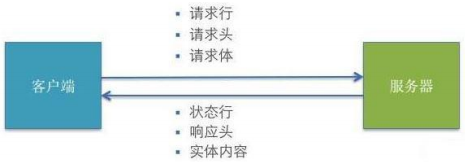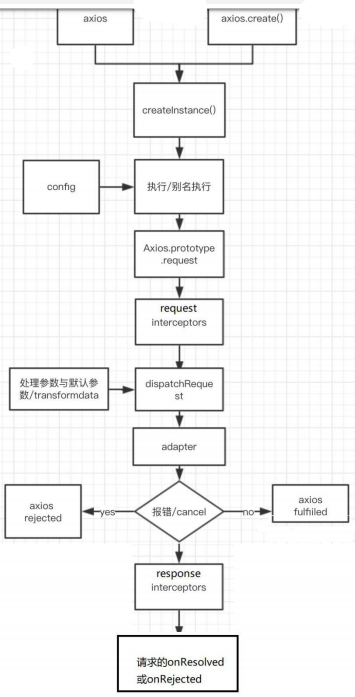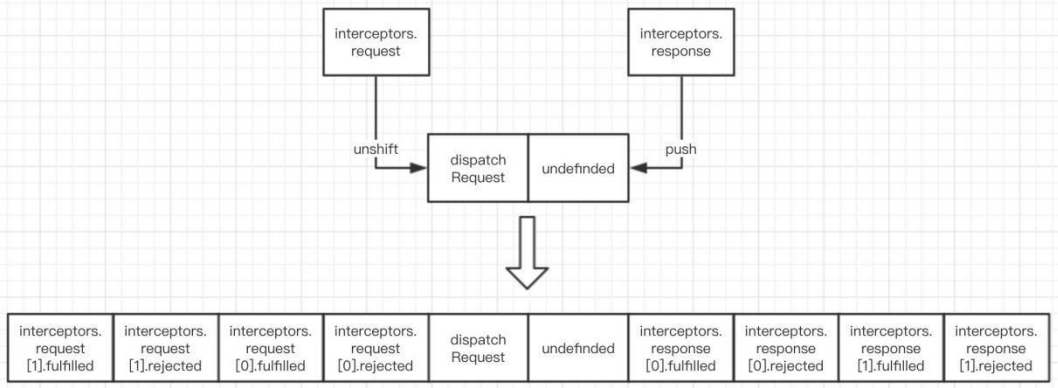HTTP 相关
MDN文档
HTTP请求交互的基本过程

- 前后应用从浏览器端向服务器发送 HTTP 请求(请求报文)
- 后台服务器接收到请求后, 调度服务器应用处理请求, 向浏览器端返回 HTTP
响应(响应报文) - 浏览器端接收到响应, 解析显示响应体/调用监视回调
HTTP请求报文
-
请求行:
method url
GET /product_detail?id=2
POST /login -
多个请求头
Host: www.baidu.com
Cookie: BAIDUID=AD3B0FA706E; BIDUPSID=AD3B0FA706;
Content-Type: application/x-www-form-urlencoded 或者 application/json -
请求体
username=tom&pwd=123
{“username”: “tom”, “pwd”: 123}
HTTP响应报文
- 响应状态行: status statusText
- 多个响应头
Content-Type: text/html;charset=utf-8
Set-Cookie: BD_CK_SAM=1;path=/ - 响应体
html 文本/json 文本/js/css/图片…
post 请求体参数格式
- Content-Type: application/x-www-form-urlencoded;charset=utf-8
用于键值对参数,参数的键值用=连接, 参数之间用&连接
例如: name=%E5%B0%8F%E6%98%8E&age=12 - Content-Type: application/json;charset=utf-8
用于 json 字符串参数
例如: {“name”: “%E5%B0%8F%E6%98%8E”, “age”: 12} - Content-Type: multipart/form-data
常见的响应状态码
200 OK 请求成功。一般用于 GET 与 POST 请求
201 Created 已创建。成功请求并创建了新的资源
401 Unauthorized 未授权/请求要求用户的身份认证
404 Not Found 服务器无法根据客户端的请求找到资源
500 Internal Server Error 服务器内部错误,无法完成请求
不同类型的请求及其作用
- GET: 从服务器端读取数据
- POST: 向服务器端添加新数据
- PUT: 更新服务器端已经数据
- DELETE: 删除服务器端数据
API 的分类
- REST API: restful
(1) 发送请求进行 CRUD 哪个操作由请求方式来决定
(2) 同一个请求路径可以进行多个操作
(3) 请求方式会用到 GET/POST/PUT/DELETE - 非 REST API: restless
(1) 请求方式不决定请求的 CRUD 操作
(2) 一个请求路径只对应一个操作
(3) 一般只有 GET/POST
使用 json-server 搭建 REST API
json-server 是什么?
用来快速搭建 REST API 的工具包
使用 json-server
-
下载: npm install -g json-server
-
目标根目录下创建数据库 json 文件: db.json
1
2
3
4
5{
"posts": [{ "id": 1, "title": "json-server", "author": "typicode" }],
"comments": [{ "id": 1, "body": "some comment", "postId": 1 }],
"profile": { "name": "typicode" }
} -
启动服务器执行命令: json-server --watch db.json
使用浏览器访问测试
使用 axios 访问测试
1 | <script src="https://cdn.bootcss.com/axios/0.19.0/axios.js"></script> |
XHR 的理解和使用
MDN 文档
https://developer.mozilla.org/zh-CN/docs/Web/API/XMLHttpRequest
理解
- 使用 XMLHttpRequest (XHR)对象可以与服务器交互, 也就是发送 ajax 请求
- 前端可以获取到数据,而无需让整个的页面刷新。
- 这使得 Web 页面可以只更新页面的局部,而不影响用户的操作。
区别一般 http 请求与 ajax 请求
- ajax 请求是一种特别的 http 请求
- 对服务器端来说, 没有任何区别, 区别在浏览器端
- 浏览器端发请求: 只有 XHR 或 fetch 发出的才是 ajax 请求, 其它所有的都是
非 ajax 请求 - 浏览器端接收到响应
(1) 一般请求: 浏览器一般会直接显示响应体数据, 也就是我们常说的刷新/
跳转页面
(2) ajax 请求: 浏览器不会对界面进行任何更新操作, 只是调用监视的回调
函数并传入响应相关数据
API
-
XMLHttpRequest(): 创建 XHR 对象的构造函数
-
status: 响应状态码值, 比如 200, 404
-
statusText: 响应状态文本
-
readyState: 标识请求状态的只读属性
0: 初始
1: open()之后
2: send()之后
3: 请求中
4: 请求完成 -
onreadystatechange: 绑定 readyState 改变的监听
-
responseType: 指定响应数据类型, 如果是’json’, 得到响应后自动解析响应体数据
-
response: 响应体数据, 类型取决于 responseType 的指定
-
timeout: 指定请求超时时间, 默认为 0 代表没有限制
-
ontimeout: 绑定超时的监听
-
onerror: 绑定请求网络错误的监听
-
open(): 初始化一个请求, 参数为: (method, url[, async])
-
send(data): 发送请求
-
abort(): 中断请求
-
getResponseHeader(name): 获取指定名称的响应头值
-
getAllResponseHeaders(): 获取所有响应头组成的字符串
-
setRequestHeader(name, value): 设置请求头
XHR 的 ajax 封装(简单版 axios)
特点
-
函数的返回值为 promise, 成功的结果为 response, 异常的结果为 error
-
能处理多种类型的请求: GET/POST/PUT/DELETE
-
函数的参数为一个配置对象
1
2
3
4
5
6{
url: '', // 请求地址
method: '', // 请求方式 GET/POST/PUT/DELETE
params: {}, // GET/DELETE 请求的 query 参数
data: {}, // POST 或 DELETE 请求的请求体参数
} -
响应 json 数据自动解析为 js
编码实现
示例代码:https://github.com/cheungww/http-ajax-axios/blob/master/test/02_xhr.html
1 | /* |
使用测试
1 | /* 1. GET请求: 从服务器端获取数据*/ |
axios 的理解和使用
axios 是什么?
- 前端最流行的 ajax 请求库
- react/vue 官方都推荐使用 axios 发 ajax 请求
- 文档: https://github.com/axios/axios
axios 特点
- 基本 promise 的异步 ajax 请求库
- 浏览器端/node 端都可以使用
- 支持请求/响应拦截器
- 支持请求取消
- 请求/响应数据转换
- 批量发送多个请求
axios 常用语法
axios(config): 通用/最本质的发任意类型请求的方式
axios(url[, config]): 可以只指定 url 发 get 请求
axios.request(config): 等同于 axios(config)
axios.get(url[, config]): 发 get 请求
axios.delete(url[, config]): 发 delete 请求
axios.post(url[, data, config]): 发 post 请求
axios.put(url[, data, config]): 发 put 请求
axios.defaults.xxx: 请求的默认全局配置
axios.interceptors.request.use(): 添加请求拦截器
axios.interceptors.response.use(): 添加响应拦截器
axios.create([config]): 创建一个新的 axios(它没有下面的功能)
axios.Cancel(): 用于创建取消请求的错误对象
axios.CancelToken(): 用于创建取消请求的 token 对象
axios.isCancel(): 是否是一个取消请求的错误
axios.all(promises): 用于批量执行多个异步请求
axios.spread(): 用来指定接收所有成功数据的回调函数的方法
难点语法的理解和使用
axios.create(config)
-
根据指定配置创建一个新的 axios, 也就就每个新 axios 都有自己的配置
-
新 axios 只是没有取消请求和批量发请求的方法, 其它所有语法都是一致的
-
为什么要设计这个语法?
(1) 需求: 项目中有部分接口需要的配置与另一部分接口需要的配置不太一
样, 如何处理
(2) 解决: 创建 2 个新 axios, 每个都有自己特有的配置, 分别应用到不同要
求的接口请求中
拦截器函数/ajax 请求/请求的回调函数的调用顺序
- 说明: 调用 axios()并不是立即发送 ajax 请求, 而是需要经历一个较长的流程
- 流程: 请求拦截器2 => 请求拦截器 1 => 发ajax请求 => 响应拦截器1 => 响
应拦截器 2 => 请求的回调 - 注意: 此流程是通过 promise 串连起来的, 请求拦截器传递的是 config, 响应
拦截器传递的是 response
1 |
|
取消请求
-
基本流程
配置 cancelToken 对象
缓存用于取消请求的 cancel 函数
在后面特定时机调用 cancel 函数取消请求
在错误回调中判断如果 error 是 cancel, 做相应处理 -
实现功能
-
点击按钮, 取消某个正在请求中的请求
1
2
3
4
5
6
7
8
9
10
11
12
13
14
15
16
17
18
19
20
21
22
23
24
25
26
27
28
29
30
31
32
33
34
35
36
37
38
39
40
41
42
43
44
45
46
47
48
49
50
51
52
53
54
55
56
57
58
59
60
61
62
63
64
<html lang="en">
<head>
<meta charset="UTF-8">
<meta name="viewport" content="width=device-width, initial-scale=1.0">
<meta http-equiv="X-UA-Compatible" content="ie=edge">
<title>取消请求</title>
</head>
<body>
<button onclick="getProducts1()">获取商品列表1</button><br>
<button onclick="getProducts2()">获取商品列表2</button><br>
<button onclick="cancelReq()">取消请求</button><br>
<script src="https://cdn.bootcss.com/axios/0.19.0/axios.js"></script>
<script>
let cancel // 用于保存取消请求的函数
function getProducts1() {
axios({
url: 'http://localhost:4000/products1',
cancelToken: new axios.CancelToken((c) => { // c是用于取消当前请求的函数
// 保存取消函数, 用于之后可能需要取消当前请求
cancel = c
})
}).then(
response => {
cancel = null
console.log('请求1成功了', response.data)
},
error => {
cancel = null
console.log('请求1失败了', error.message, error)
}
)
}
function getProducts2() {
axios({
url: 'http://localhost:4000/products2'
}).then(
response => {
console.log('请求2成功了', response.data)
},
error => {
cancel = null
console.log('请求2失败了', error.message)
}
)
}
function cancelReq() {
// alert('取消请求')
// 执行取消请求的函数
if (typeof cancel === 'function') {
cancel('强制取消请求')
} else {
console.log('没有可取消的请求')
}
}
</script>
</body>
</html> -
在请求一个接口前, 取消前面一个未完成的请求
未用拦截器
1
2
3
4
5
6
7
8
9
10
11
12
13
14
15
16
17
18
19
20
21
22
23
24
25
26
27
28
29
30
31
32
33
34
35
36
37
38
39
40
41
42
43
44
45
46
47
48
49
50
51
52
53
54
55
56
57
58
59
60
61
62
63
64
65
66
67
68
69
70
71
72
73
74
75
76
77
78
79
80
81
82
83
84
85
86
87
88
89
90
91
<html lang="en">
<head>
<meta charset="UTF-8">
<meta name="viewport" content="width=device-width, initial-scale=1.0">
<meta http-equiv="X-UA-Compatible" content="ie=edge">
<title>取消请求</title>
</head>
<body>
<button onclick="getProducts1()">获取商品列表1</button><br>
<button onclick="getProducts2()">获取商品列表2</button><br>
<button onclick="cancelReq()">取消请求</button><br>
<script src="https://cdn.bootcss.com/axios/0.19.0/axios.js"></script>
<script>
let cancel // 用于保存取消请求的函数
function getProducts1() {
// 在准备发请求前, 取消未完成的请求
if (typeof cancel === 'function') {
cancel('取消请求')
}
axios({
url: 'http://localhost:4000/products1',
cancelToken: new axios.CancelToken((c) => { // c是用于取消当前请求的函数
// 保存取消函数, 用于之后可能需要取消当前请求
cancel = c
})
}).then(
response => {
cancel = null
console.log('请求1成功了', response.data)
},
error => {
if (axios.isCancel(error)) {
// cancel = null
console.log('请求1取消的错误', error.message)
} else { // 请求出错了
cancel = null
console.log('请求1失败了', error.message)
}
}
)
}
function getProducts2() {
// 在准备发请求前, 取消未完成的请求
if (typeof cancel === 'function') {
cancel('取消请求')
}
axios({
url: 'http://localhost:4000/products2',
cancelToken: new axios.CancelToken((c) => { // c是用于取消当前请求的函数
// 保存取消函数, 用于之后可能需要取消当前请求
cancel = c
})
}).then(
response => {
cancel = null
console.log('请求2成功了', response.data)
},
error => {
if (axios.isCancel(error)) {
// cancel = null
console.log('请求2取消的错误', error.message)
} else { // 请求出错了
cancel = null
console.log('请求2失败了', error.message)
}
}
)
}
function cancelReq() {
// alert('取消请求')
// 执行取消请求的函数
if (typeof cancel === 'function') {
cancel('强制取消请求')
} else {
console.log('没有可取消的请求')
}
}
</script>
</body>
</html>用了请求/响应拦截器
1
2
3
4
5
6
7
8
9
10
11
12
13
14
15
16
17
18
19
20
21
22
23
24
25
26
27
28
29
30
31
32
33
34
35
36
37
38
39
40
41
42
43
44
45
46
47
48
49
50
51
52
53
54
55
56
57
58
59
60
61
62
63
64
65
66
67
68
69
70
71
72
73
74
75
76
77
78
79
80
81
82
83
84
85
86
87
88
89
90
91
92
93
94
95
96
<html lang="en">
<head>
<meta charset="UTF-8">
<meta name="viewport" content="width=device-width, initial-scale=1.0">
<meta http-equiv="X-UA-Compatible" content="ie=edge">
<title>取消请求</title>
</head>
<body>
<button onclick="getProducts1()">获取商品列表1</button><br>
<button onclick="getProducts2()">获取商品列表2</button><br>
<button onclick="cancelReq()">取消请求</button><br>
<script src="https://cdn.bootcss.com/axios/0.19.0/axios.js"></script>
<script>
// 添加请求拦截器
axios.interceptors.request.use((config) => {
// 在准备发请求前, 取消未完成的请求
if (typeof cancel === 'function') {
cancel('取消请求')
}
// 添加一个cancelToken的配置
config.cancelToken = new axios.CancelToken((c) => { // c是用于取消当前请求的函数
// 保存取消函数, 用于之后可能需要取消当前请求
cancel = c
})
return config
})
// 添加响应拦截器
axios.interceptors.response.use(
response => {
cancel = null
return response
},
error => {
if (axios.isCancel(error)) {// 取消请求的错误
// cancel = null
console.log('请求取消的错误', error.message) // 做相应处理
// 中断promise链接
return new Promise(() => { })
} else { // 请求出错了
cancel = null
// 将错误向下传递
// throw error
return Promise.reject(error)
}
}
)
let cancel // 用于保存取消请求的函数
function getProducts1() {
axios({
url: 'http://localhost:4000/products1',
}).then(
response => {
console.log('请求1成功了', response.data)
},
error => {// 只用处理请求失败的情况, 取消请求的错误的不用
console.log('请求1失败了', error.message)
}
)
}
function getProducts2() {
axios({
url: 'http://localhost:4000/products2',
}).then(
response => {
console.log('请求2成功了', response.data)
},
error => {
console.log('请求2失败了', error.message)
}
)
}
function cancelReq() {
// alert('取消请求')
// 执行取消请求的函数
if (typeof cancel === 'function') {
cancel('强制取消请求')
} else {
console.log('没有可取消的请求')
}
}
</script>
</body>
</html>
-
axios 源码分析
源码目录结构
1 | ├── /dist/ # 项目输出目录 |
官方库:https://github.com/axios/axios
含中文注释的axios库:https://github.com/cheungww/axios
源码分析
axios 与 Axios 的关系?
- 从语法上来说: axios 不是 Axios 的实例
- 从功能上来说: axios 是 Axios 的实例
- axios 是 Axios.prototype.request 函数 bind()返回的函数
- axios 作为对象有 Axios 原型对象上的所有方法, 有 Axios 对象上所有属性
instance 与 axios 的区别?
- 相同:
(1) 都是一个能发任意请求的函数: request(config)
(2) 都有发特定请求的各种方法: get()/post()/put()/delete()
(3) 都有默认配置和拦截器的属性: defaults/interceptors - 不同:
(1) 默认匹配的值很可能不一样
(2) instance 没有 axios 后面添加的一些方法: create()/CancelToken()/all()
axios 运行的整体流程

-
整体流程:
request(config) ==> dispatchRequest(config) ==> xhrAdapter(config) -
request(config):
将请求拦截器 / dispatchRequest() / 响应拦截器 通过 promise 链串连起来, 返回 promise -
dispatchRequest(config):
转换请求数据 ==> 调用 xhrAdapter()发请求 ==> 请求返回后转换响应数
据. 返回 promise -
xhrAdapter(config):
创建 XHR 对象, 根据 config 进行相应设置, 发送特定请求, 并接收响应数据, 返回 promise
axios 的请求/响应拦截器是什么?

-
请求拦截器:
在真正发送请求前执行的回调函数
可以对请求进行检查或配置进行特定处理
成功的回调函数, 传递的默认是 config(也必须是)
失败的回调函数, 传递的默认是 error -
响应拦截器
在请求得到响应后执行的回调函数
可以对响应数据进行特定处理
成功的回调函数, 传递的默认是 response
失败的回调函数, 传递的默认是 error
axios 的请求/响应数据转换器是什么?
- 请求转换器: 对请求头和请求体数据进行特定处理的函数
1 | if (utils.isObject(data)) { |
- 响应转换器: 将响应体 json 字符串解析为 js 对象或数组的函数
response.data = JSON.parse(response.data)
response 的整体结构
1 | { |
error 的整体结构
1 | { |
如何取消未完成的请求?
- 当配置了 cancelToken 对象时, 保存 cancel 函数
(1) 创建一个用于将来中断请求的 cancelPromise
(2) 并定义了一个用于取消请求的 cancel 函数
(3) 将 cancel 函数传递出来 - 调用 cancel()取消请求
(1) 执行 cacel 函数, 传入错误信息 message
(2) 内部会让 cancelPromise 变为成功, 且成功的值为一个 Cancel 对象
(3) 在 cancelPromise 的成功回调中中断请求, 并让发请求的 proimse 失败, 失败的 reason 为 Cacel 对象